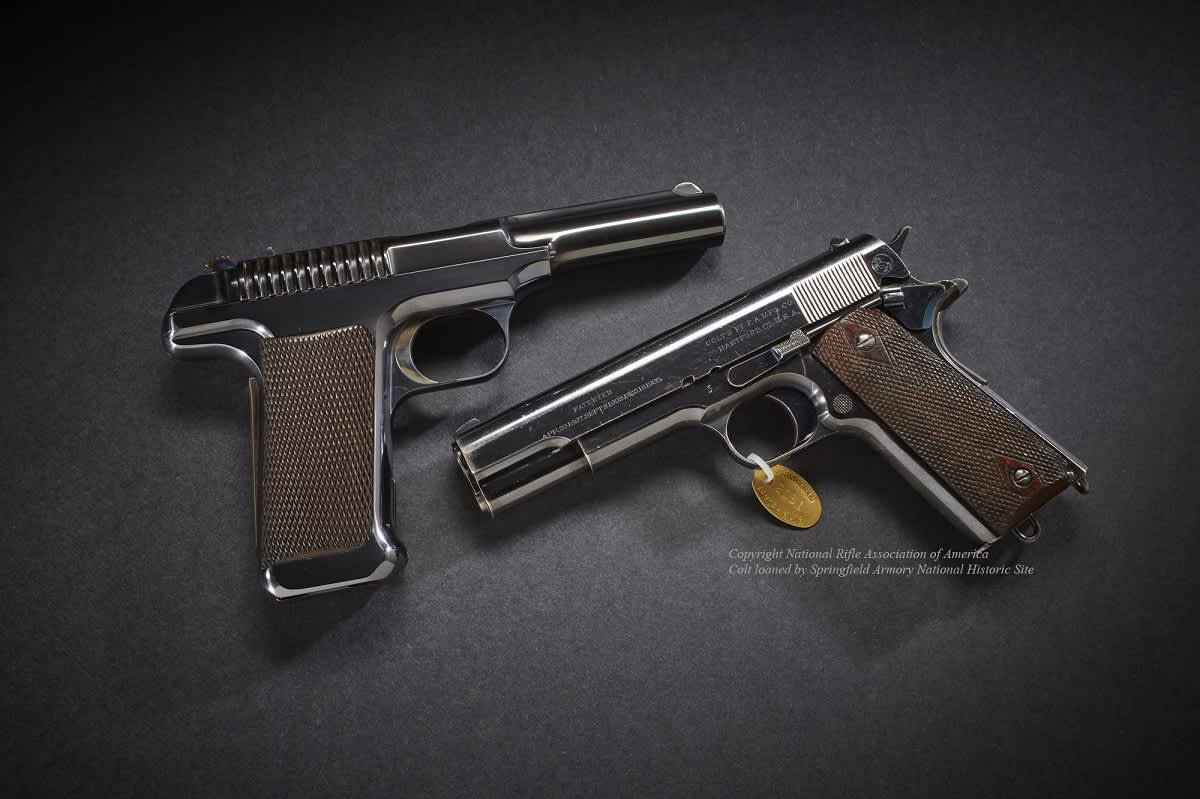Peer into the History of the 1911 Pistol at the NRA National Firearms Museum
K.J. Houtman 07.27.15

If you asked just about any firearms enthusiast “Which handgun has had the greatest impact on the gun industry over the last century?”, most would answer “John Moses Browning’s 1911.” A look at the fascinating story of the development of that famous pistol is now available to the public thanks to a new exhibit at the NRA National Firearms Museum in Fairfax, Virginia.
While the military put forth some effort to obtain a modern, standardized handgun in the late 1890s and early 1900s, it wasn’t until 1907 a call to get serious about a .45 caliber pistol occurred and tests began in earnest—it was time for a reliable and effective military-issue sidearm with true stopping power.
Inventors and manufacturers heeded the call, submitting handguns for trial and evaluation to determine the arm “best suited for adoption for use principally by the cavalry and light artillery of the United States Army.” Specifications called for a capacity of six rounds or better, chambered for the M1906 .45 cartridge.
Colt and Smith & Wesson submitted double-action revolvers, while automatic pistols came from Colt, Savage, DWM Luger, Bergmann, White Merrill, and Knoble. Webley submitted a hybrid, the Webley-Fosbery automatic revolver. Not all made it to the rust-and-dust evaluations. The revolvers were eliminated quickly as not ideal for military conditions, and two finalists remained: the automatic pistols from Colt and Savage. In 1907, both companies were asked to submit 200 guns for additional field tests.
Nearly 200 military officers carried (and used) the test models, but both manufacturers (Colt and Savage) had issues in service. In 1910, neither was deemed “sufficiently reliable” or with “sufficient endurance” to compare with the .45 caliber Colt double-action revolver tested alongside them.
Colt and Savage continued to make improvements based on feedback from the soldiers. Eventually, each company furnished a pistol for a 12-hour, 6,000-round torture test in March 1911. They were the Colt with serial number 5 fired by E.G. Reising and the Savage with serial number 4 fired by Charles Nelson. Each shooter was instructed to follow a protocol incorporating a five-minute cooling period after each 100-round stage, and a thorough cleaning and oiling after each 1,000-round mark.

It started as a dead heat. For the first 1,000 rounds, both pistols functioned flawlessly. However, as the test wore on, the Savage experienced breakage and failure while the Colt continued through all 6,000 rounds without a hiccup.
After the smoke cleared, the Board of Officers overseeing the trials concluded:
The Colt pistol embodies all the features considered essential, desirable and preferable by the Board of Officers… [and] therefore recommends that the Colt Automatic Pistol of the design submitted to the board be adopted for use by foot and mounted troops in the military service, in consequence of its marked superiority to the present service revolvers, and to any other known pistol, of its extreme reliability and endurance and of its fulfillment of all essential requirements.
The improved Colt design won the right to become the U.S. Pistol, Model of 1911, known to many today in its various forms as the 1911 pistol.
The Colt and Savage pistols from the 1911 shootout, along with several pistols from the 1908 to 1910 test periods, are part of the NRA National Firearms Museum’s “America’s Pistol” exhibit that opened last Friday.
If you’re interested in firearms or history, now is your chance to get up close and personal with these relics of America’s military. The National Firearms Museum is open seven days a week and free to attend. Don’t miss out!
K.J. Houtman is the author of the award-winning Fish On Kids Books series, chapter books for eight- to 12-year-olds with adventures based around fishing, camping, and hunting. Her work is available at Amazon and local bookstores. Find out more at fishonkidsbooks.com. This article was produced in cooperation with the NRA.

